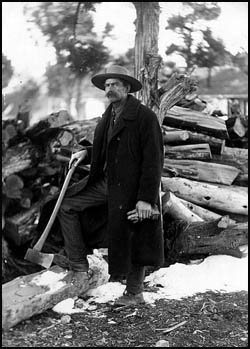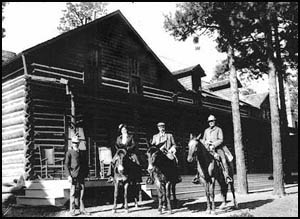| ALL HIKERS
HISTORICAL FIGURES |
PETE BERRY
(1858-1932)
|

Pete Berry
Grand Canyon National
Park Museum Collection |
Peter D. "Pete" Berry
learned in 1887 that his older brother John, who ran a Flagstaff saloon, had
been shot to death trying to break up a barroom brawl. Pete left Pitkin,
Colorado, and went to Flagstaff to settle his brother's affairs and manage the
saloon. There he met and married Martha Thompson. Almost immediately
after arriving in Flagstaff, he began prospecting with three brothers: Burton,
Niles, and Ralph Cameron. Berry filed a claim and built a temporary cabin
at Grandview Point in 1888. The partners filed dozens of claims in 1890.
Then in 1892 on Horseshoe Mesa, they discovered the more famous of their four
mines, the Last Chance Mine, which contained high-grade copper ore. Berry,
the Camerons, and a few others began work on a three-mile trail from their rim
millsite to the mines. They worked dawn to dusk six and seven days per
week, completing the "Grand View Toll Trail" in 1893. Berry and the Camerons organized their claims into the Grand Canyon Copper Company. In
1902 while times were good, they sold the mines, trail, and millsite to Henry P.
Barbour, who continued the operation. In 1907 when the price of copper
dropped dramatically, the mines closed for good. Many mining artifacts
remain on Horseshoe Mesa.
|

Grandview Hotel
Cline Library, NAU |
Although mining
activity at Grandview Point was bustling in the late 1800s, Berry diversified his interests to
take advantage of growing numbers of Grand Canyon vacationers. Beginning
in 1892, he replaced an earlier temporary structure with a formidable log
building, and continued to improve it until by 1897 he had completed the
Grandview Hotel. He and Martha decorated the rustic interior with Navajo
blankets, Hopi crafts, and simple homemade furnishings. It remained the
best decorated and roomiest hotel until the El Tovar opened in 1905. Berry
put up a three-story building on his adjacent 160-acre homestead and opened it
as the Summit Hotel. Continuing competitive pressure from the Santa Fe
Railroad and Fred Harvey Companies along with declining copper prices forced all
Grandview ventures to close in 1907. In 1913 Berry sold his homestead and
the Summit Hotel to millionaire newspaperman William Randolph Hearst for
forty-eight thousand dollars. He later sold the Grandview Hotel and his
remaining mining claims to Hearst for an additional twenty-five thousand
dollars.
|

Martha, Pete,
Ralph's wife, Ralph Berry
Grand Canyon National
Park Museum Collection |
In 1919 Pete and Martha
moved five miles to the southeast to the fifty-acre homestead of his son, Ralph.
His son died that year of the influenza. They remained at the ranch
earning a little money trapping and selling Navajo rugs. Martha died in
1931 and Pete died the following year. Both are buried in the Grand Canyon
Pioneer Cemetery. Pete Berry claimed and developed one of the few paying mines
ever opened within the Grand Canyon. He built a hotel and remained to
compete with railroad interests nearly to the end of the pioneer period.
Source material for this story: Living at
the Edge by Michael F. Anderson
MAIN INDEX
|
BACK TO HISTORICAL FIGURES
|
Copyright © Richard M. Perry, 2004-2024. All rights reserved. This web site, its text, and pictures may not be
copied without the express written consent of Richard
M. Perry. |
|


